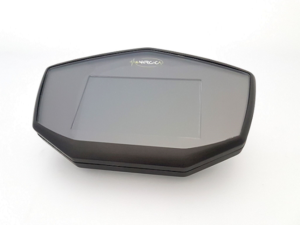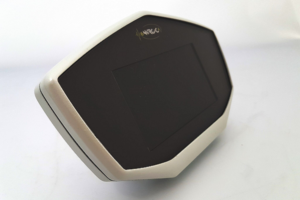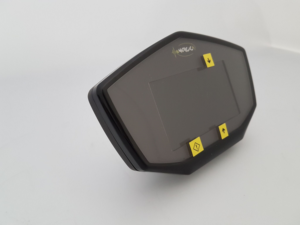 The 3D printed Energica Ego electric motorcycle debuted in 2016 by CRP Group subsidiary Energica. The Italian company uses CRP’s advanced, high performance Windform materials to 3D print the components for the motorcycle, which was on display at CES 2018.
The 3D printed Energica Ego electric motorcycle debuted in 2016 by CRP Group subsidiary Energica. The Italian company uses CRP’s advanced, high performance Windform materials to 3D print the components for the motorcycle, which was on display at CES 2018.
Energica is also developing the Ego Corsa motorbike for teams to race in next year’s FIM Enel MotoE World Cup.
 The CRP Group, also headquartered in Italy, recently put out two case studies that break down the development and manufacturing of Energica’s 3D printed motorbike components – the dashboard, seat, and seat plate. In creating the prototypes for these parts, the company was able to complete full studies in order to lower the margin for error with injection molds.
The CRP Group, also headquartered in Italy, recently put out two case studies that break down the development and manufacturing of Energica’s 3D printed motorbike components – the dashboard, seat, and seat plate. In creating the prototypes for these parts, the company was able to complete full studies in order to lower the margin for error with injection molds.
The 3D printed active matrix dashboard gives its motorcycles a real Human Machine Interface, and supports interactivity and information flow with the vehicle system. It has a display with 16.7 million active matrix colors for great visibility, and provides the rider with an extensive, but easy to read, menu of advanced user diagnostics and configurations.
The dashboard needed to contain, protect, and isolate complex electronics. So CRP Technology constructed three functional dashboard prototypes, using its SLS technology and polyamide-based composite Windform LX 3.0, which is reinforced with glass fiber.
- Prototype 1
- Prototype 2
- Prototype 3
The shell for the first prototype was made in two parts, and the electric components were easily assembled, then secured with glue.
Energica said in the case study, “Our suppliers of traditional technology (mould makers) would have taken roughly five months to prepare the prototype moulds. Thanks to CRP Technology and the Windform composite materials, we received the prototype in two days.”
Once this prototype was returned to Energica, it was mounted directly on the bike and road-tested. Even under stressful conditions, the prototype was able to protect the sophisticated electronic components inside, thanks to the non-conductive Windform LX 3.0 material that can produce parts able to stand up under impacts and vibrations.
The second prototype was painted so color tests could be conducted, and the third is a hybrid, with the lower part 3D printed with Windform LX 3.0 material and the top fabricated with plastic injection molding. This allowed Energica and Cobo, its injection mold supplier, to perform precise assembly tests, which delivered positive results. The calculated tolerances of the plastic injection were the same as the composite Windform material.After Energica approved the project, Cobo developed the mold for industrial production.
“We used the functional prototypes of the dashboard for roughly six months, subjecting them to every kind of stress during the test rides,” Energica said in the case study.
“Thanks to the prototypes in 3D printing and Windform, we have been able to work with the mould makers in a new way. These functional components, which are much more than just aesthetic prototypes, allowed us to examine the application, and annotate some improvements for the final mould. We therefore saved time and money: when we gave the authorization to proceed with injection moulding, we knew that the pieces would come out perfect and ready to be used.”
The CRP Group also used its professional 3D printing technology and Windform materials to construct two functional prototypes of the Energica motorcycle seat for R&D and testing phases.
A resistant seat plate supports the weight-bearing soft seat, which guarantees flexibility so the rider can avoid any damage that may result from riding the bike on rough roads. The seat opens so the rider can access a charging socket, so its opening and closing mechanism is a pretty important part of the design.Motorcycle seats need to be aesthetically pleasing and reliable, as well as comfortable and resistant to impact and weather. That’s why CRP Technology used its durable Windform RL rubber-like composite material for the soft seat of the first prototype – the thermoplastic elastomer simulates foam, and its mechanical characteristics are well-suited for 3D printing applications where flexibility and complex geometries are required.Windform GT, a polyamide glass fiber-reinforced composite material, was used to make the seat plate for this prototype, as it’s perfect for applications requiring elasticity and resistance. The soft seat and seat plate were then bonded, and the component coated, by using staples to affix material over the two. The completed prototype was then mounted on the bike and road-tested by Energica.
Energica noticed the first prototype had a slight bend, so CRP Technology added a ribbed structure for stiffness to the base of the second prototype’s seat plate. This new version was 3D printed using Windform GT, and the soft seat was made of foam.
Testing of the second prototype achieved positive results, as the bending issue was fixed. As was the case with the dashboard, once Energica approved the project, the mold was developed for industrial production.
“The availability of a whole range of high performance composite materials, the Windforms, for the creation and manufacture of Energica functional prototypes was the key: with the support of CRP technicians, we selected the Windform materials closest to the plastic one,” said Energica in the case study.
“Additive Manufacturing and Windform materials by CRP Technology, have allowed us a comprehensive approach on the prototypes, carrying out all the tests both static and on the road.
“Plus we have been able to work with the mould makers in a new way. These functional components, which are much more than just aesthetic prototypes, allowed us to examine the application, and annotate some improvements for the final mould. We therefore saved time and money: when we gave the authorization to proceed with injection moulding, we knew that the pieces would come out perfect and ready to be used.”
Using 3D printing technology and Windform materials, Energica was able to reduce product development time, and test the prototype components on the motorbike.
Discuss this and other 3D printing topics, at 3DPrintBoard.com or share your thoughts below.
[Images provided by CRP Group]
Subscribe to Our Email Newsletter
Stay up-to-date on all the latest news from the 3D printing industry and receive information and offers from third party vendors.
You May Also Like
New Report: Semiconductor Industry to See $1.4B in 3D Printing Revenues by 2032
“The semiconductor sector has become the most strategically significant area of global industry.” Truer words are hard to come by when it comes to the modern world, and they are...
Will Photonic-Crystal Lasers Revolutionize 3D Printing?
Powder bed fusion (PBF) for metals and polymers predominantly utilizes lasers as the primary heat source. Some directed energy deposition (DED) technologies also employ lasers, while various vat polymerization methods...
3D Printing Unpeeled: Orbex Investment, IndoMIM and HP, Ultrasonic Waves
INDO-MIM has bought three HP Metal Jet S100 printers, operating two in India and one in Texas. This is a win for HP because the company has deep experience in...
3D Printing Webinar and Event Roundup: April 21, 2024
It’s another busy week of webinars and events, starting with Hannover Messe in Germany and continuing with Metalcasting Congress, Chinaplas, TechBlick’s Innovation Festival, and more. Stratasys continues its advanced training...







































